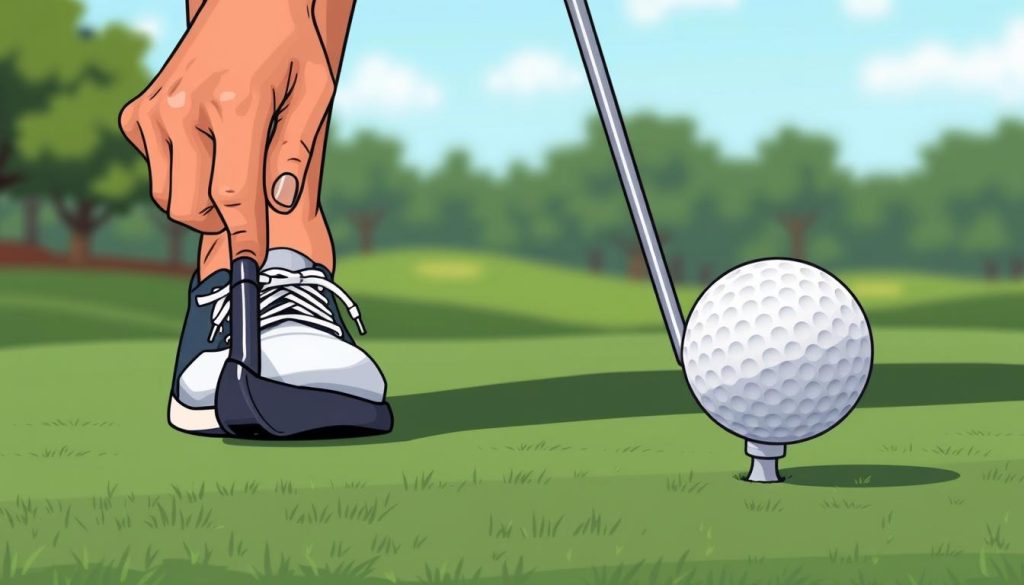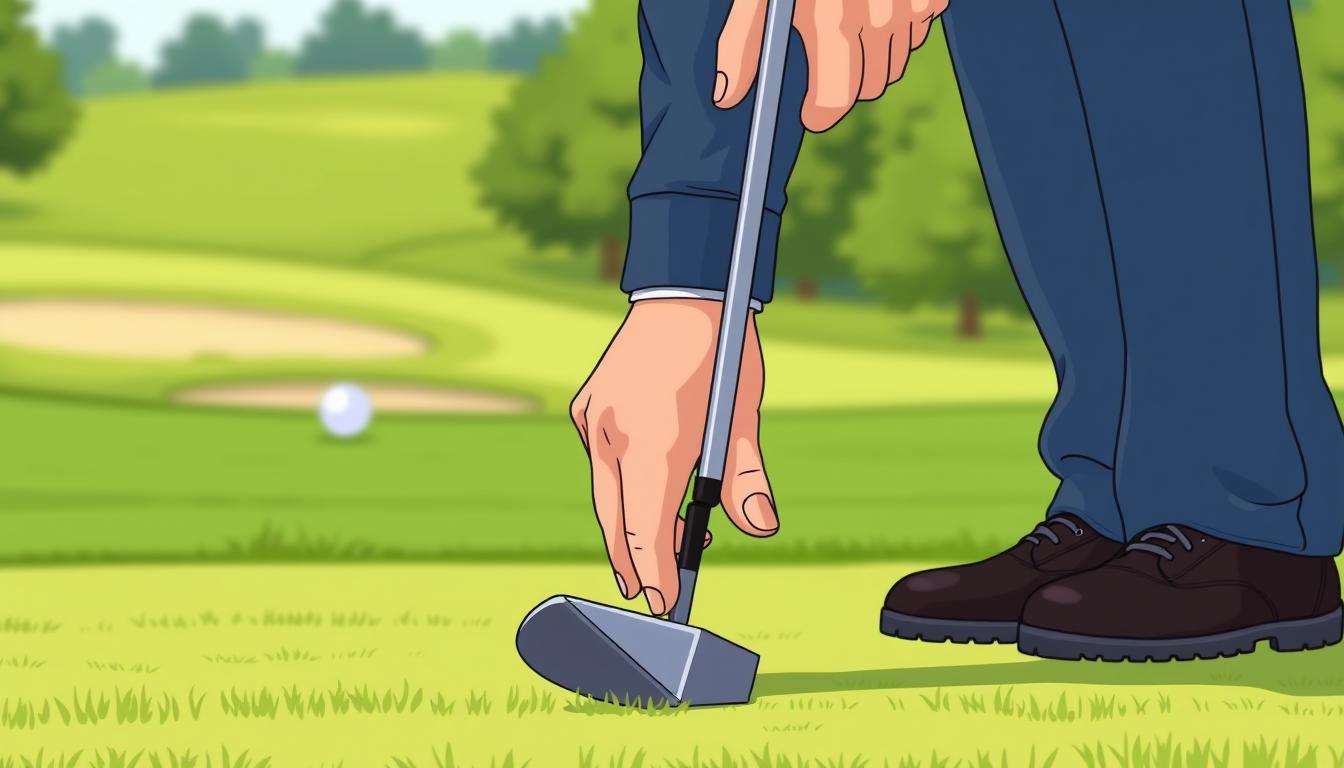Mastering the putting stroke is key to lowering your golf scores. This guide will help you improve your short game. We’ll cover the basics of the putting stroke, from swing mechanics to short game drills.
Brad Faxon, known for his great putting, stresses the need for a smooth stroke. He suggests a 2-1 backswing to downswing ratio for a stable putt. This rhythm keeps your stroke consistent and controlled.
Finding the right putter length is crucial. Faxon recommends measuring from your wrist crease to the ground. This ensures your putter fits comfortably and accurately.
Your grip is vital for putting success. Many pros, like Faxon, Jack Nicklaus, and Arnold Palmer, use a finger-based grip. This grip offers better control and feel during your putt.
Key Takeaways
- Maintain a 2-1 backswing to downswing ratio for stability
- Choose a putter length that matches your natural stance
- Use a finger-based grip for better control
- Keep grip pressure light for improved feel
- Develop a consistent pre-shot routine
- Practice visualization to enhance stroke fluidity
- Focus on a relaxed, instinct-based approach to putting
Understanding the Fundamentals of a Perfect Putting Stroke
Mastering the putting stroke is a journey that requires skill and a deep understanding of the game. It combines physics, mechanics, and precision for consistent results on the green.
The Physics Behind a Pendulum Motion
The putting stroke mirrors a pendulum’s rhythmic movement. This motion emphasizes a steady tempo throughout the stroke. By focusing on a smooth, pendulum-like action, golfers can improve their putting stroke analysis and achieve more consistent results.
Key Components of Stroke Mechanics
Successful putting involves several critical elements. These include proper grip, stance, alignment, and stroke technique. Golf swing mechanics play a crucial role in developing a reliable putting stroke. Let’s break down these components:
- Grip: Maintain a light grip pressure for better control
- Stance: Adopt a comfortable posture with your eyes directly over the ball
- Alignment: Ensure a square putter face at address
- Stroke: Minimize arm and wrist movement for a smoother motion
Impact Position Fundamentals
The moment of impact is critical in putting. To promote solid contact, focus on these key aspects:
- Keep your body steady throughout the stroke
- Maintain light grip pressure
- Develop a consistent pre-shot routine
- Accelerate through the ball with locked wrists
Incorporating these fundamentals into your putting stroke drills will help you develop a more consistent and effective technique on the green.
| Putter Type | Shaft Length (inches) | Shaft Length (cm) |
|---|---|---|
| Conventional | 28-35 | 71-89 |
| Belly | 40-45 | 101-114 |
| Long | 46-55 | 116-140 |
By understanding these fundamentals and practicing regularly, you’ll be well on your way to improving your putting stroke and lowering your scores on the green.
Setting Up Your Putting Stance for Success
Your putting stance is the base of a good stroke. Learning how to set up is crucial for better putting. Let’s look at the key parts of a good putting stance.
Ball Position and Alignment
Put the ball a bit ahead of your center. This helps the ball roll smoothly. Make sure your shoulders, hips, knees, and feet line up with the target. This keeps your body in sync with your putt.
Weight Distribution
Spread your weight evenly on both feet. Your feet should be shoulder-width apart. This balance helps keep your stroke steady. A stable base is key for consistent putting.
Eye Position Over the Ball
Look straight over the ball. This view helps you see the putt’s path. Keep your arms and hands under your shoulders and your knees slightly bent. This setup helps you make accurate putts.
Practice is key. Use these setup tips in your drills to get better. With a solid foundation, you’ll make more putts and lower your scores.
Putting Stroke Technique Guide
Learning the putting stroke technique is key to better golf scores. The secret is in the pendulum motion, like a grandfather clock’s swing. This method helps keep your arms and wrists still, leading to more consistent and accurate putts.
Your stance is crucial for a perfect stroke. Stand with your feet, legs, arms, and shoulders aligned with the target line. Keep your weight balanced and your posture steady to avoid swaying.
How hard you grip the putter matters too. Use light pressure to let your shoulders, arms, and hands move naturally. A relaxed grip helps you swing smoothly, like a pendulum.
To get better at putting, try these drills:
- Use a small target, like a dime, to improve your aim
- Practice with exaggerated swings to build muscle memory
- Look at the hole while putting to boost your confidence
The length of your backstroke affects the distance, not the speed. Keep your wrists firm at impact and speed up through the ball. Many golfers find success by using a 2:1 ratio of backswing to downswing.
| Putter Type | Shaft Length (inches) | Shaft Length (cm) |
|---|---|---|
| Conventional | 28-35 | 71-89 |
| Belly | 40-45 | 101-114 |
| Long | 46-55 | 116-140 |
By practicing these techniques and adding them to your routine, you’ll see your putting improve. Remember, being consistent is the key to mastering putting.
Mastering the Grip Pressure and Hand Position
Grip consistency is key to perfecting your putting stroke. Different grip styles are used by golfers, but keeping your hand position the same is crucial. Let’s look at grip styles, pressure control, and wrist management to improve your short game.
Different Grip Styles and Their Benefits
Putting involves various grip styles, each with its own benefits. The traditional grip has the left hand on top for right-handed golfers. Viktor Hovland, on the other hand, uses a “left-hand low” or “cross-handed” grip. This grip can reduce wrist action and provide balanced pressure, helping both right and left-handed players.
| Grip Style | Characteristics | Benefits |
|---|---|---|
| Traditional | Left hand on top, right hand below | Familiar, natural feel |
| Cross-handed | Right hand on top, left hand below | Reduced wrist action, balanced pressure |
| Claw | Modified right hand position | Enhanced control, minimized wrist movement |
Maintaining Consistent Pressure
Using light grip pressure is vital for a smooth stroke. It allows for natural movement and keeps the putter on the target line. Practice different grip pressures on the driving range to see their effects. A firm but not too tight grip is best for your short game.
Wrist Control During the Stroke
Wrist control is crucial in putting. Professional golfers limit wrist motion for consistency. To improve, keep your wrists stable during the stroke. Use tools like the OnePuttPro™ smart putting trainer to master your grip and wrist control.
By mastering these grip techniques, you’ll see big improvements in your putting. Remember, practice is essential to make these skills part of your short game.
The Role of Tempo in Your Putting Stroke
Tempo is key in your putting stroke technique. A steady rhythm can greatly boost your performance on the green. Let’s explore why tempo matters and how it impacts your stroke.
Elite golfers keep a 2:1 ratio of backswing to downswing time in their putting. This means the backswing is twice as long as the forward stroke. This ratio is consistent, no matter the length of the putt.
Most skilled putters swing at 72 to 80 beats per minute. This steady pace helps control and makes the stroke more consistent. In fact, keeping a consistent tempo is more important than the stroke’s quality.
| Aspect | Impact on Putting Performance |
|---|---|
| Consistent Tempo | 30% improvement in distance control |
| Proper Rhythm | 25% increase in accuracy |
| 2:1 Backswing to Downswing Ratio | 20% more putts made from 10-15 feet |
To better your putting stroke, try this drill: Swing your putter back and forth, counting “one-two” on the backswing and “three” on the forward stroke. This simple drill can help you learn the right tempo.
Mastering tempo is crucial for a good putting stroke. By focusing on tempo, you can greatly improve your putting and lower your scores on the green.
Face Control and Path Management
Mastering face control and path management is key for putting. These elements are at the heart of golf swing mechanics. They are crucial for better putting accuracy.
Square Face at Impact
A square putter face at impact is essential for straight putts. Good putters use a 60:40 stroke ratio. This means a shorter follow-through than backstroke.
This technique helps square the face and hit the sweet spot every time.
Understanding Arc vs Straight Back-Straight Through
Many golfers aim for a straight back-straight through motion. But, a slight arc is natural. The goal is to swing the putter back and through the same distance.
This creates a pure 50:50 stroke. It improves control and consistency.

Path Direction Control
Controlling the path direction is crucial in putting. The path and face angle at impact determine the putt’s trajectory. Tools like TIBA Putt or Blast Motion Golf can help improve your stroke path and timing.
To improve your putting, try this: place three dots on your ball instead of a line. Put one dot in the largest clean space, then imagine two more spots forming a path to the hole. This method promotes a more athletic, reactive approach to putting.
| Putting Element | Ideal Technique | Benefit |
|---|---|---|
| Stroke Ratio | 60:40 (backstroke:follow-through) | Improves consistency and control |
| Face at Impact | Square | Ensures straight putts |
| Path | Slight arc | Natural motion for most golfers |
Developing Distance Control
Mastering distance control is key to better putting. Focus on stroke length, not speed, for accuracy and consistency. Let’s look at some drills to boost your short game.
The Tee Ladder drill is popular. Place tees at 5, 10, and 15 feet from the hole. They should be 9-12 inches apart. This drill helps you practice different distances and feel for stroke lengths.
For better distance judgment, try the Leap Frog Drill. Set markers 5 and 20 feet apart. Practice putting balls further between them. This drill helps you judge distances and adjust your stroke.
The 5 Golf Ball Drill is great for fine-tuning distance control. Place five balls near a yellow marker. Focus on your stroke without looking at the target. This drill improves muscle memory and consistency.
| Distance | Recommended Backstroke Length | Recommended Backstroke Speed |
|---|---|---|
| 3 ft | 4.5 inches | 1.5 MPH |
| 6 ft | 6 inches | 2 MPH |
| 12 ft | 8.5 inches | 3 MPH |
Keep your backstroke and forward swing tempo ratio at 2:1. Regular practice of these drills will help you put smoothly and improve your game.
The Mental Game of Putting
Mastering the mental side of putting is key to bettering your golf game. While knowing the basics of putting and your swing is important, your mental game can greatly affect your performance. It’s what can make or break your game on the green.
Visualization Techniques
Top putters use their right brain to picture successful putts. This method taps into the “athletic mind,” giving them direct access to putting knowledge without thinking too much. Try to see the ball going into the hole before you make your shot.

Pre-shot Routine Development
Having a consistent pre-shot routine is vital for staying focused and consistent. Almost all Tour Players have a specific process for putting, which includes reading the green and boosting their confidence. Create a routine that fits you, with things like deep breaths or positive affirmations.
Building Confidence on the Green
Building confidence comes from practice and positive experiences. Use short game drills to improve your connection with putts and to stay focused under pressure. Remember, putting makes up 30-40% of your score, so spending time on mental preparation is essential.
| Mental Technique | Benefit | Implementation |
|---|---|---|
| Visualization | Engages intuitive athletic mind | Imagine successful putts before shooting |
| Pre-shot Routine | Improves focus and consistency | Develop a personal routine with calming elements |
| Positive Distractions | Quiets ego-driven thoughts | Use deep breaths or counting during crucial moments |
By adding these mental strategies to your putting practice, you’ll likely see your game improve. Remember, putting is the most mental part of golf. Working on these skills can greatly enhance your natural ability on the green.
Common Putting Stroke Mistakes to Avoid
Putting is a key part of golf, with pros making 8-foot putts 50% of the time. To get better, it’s important to know and fix common mistakes. Let’s look at some common errors in putting stroke analysis and golf swing mechanics.
One big mistake is having inconsistent wrist motion. This can cause poor contact and wrong putts. To improve, keep your wrists steady. Try using a pendulum motion, which 70% of golfers find helpful for consistency.
Another mistake is having a bad tempo. Many golfers either rush or hesitate during their putts. This messes up the stroke’s natural flow. Try counting “1-2” in your head, with “1” for the backswing and “2” for the forward stroke to keep a steady pace.
| Mistake | Impact | Correction |
|---|---|---|
| Inconsistent wrist motion | Poor contact, inaccurate putts | Stabilize wrists, use pendulum motion |
| Poor tempo | Disrupted rhythm, inconsistent results | Count “1-2” for backswing and forward stroke |
| Improper alignment | Missed putts, even with good stroke | Use alignment aids, practice with putting mirror |
Many golfers, up to 80%, struggle with alignment. Even with a great stroke, being off can mean missing the putt. Use aids on your putter or practice with a mirror to get better. Remember, making it inside 10 feet of the hole boosts your chances of success.
By fixing these common mistakes, you can improve your golf swing and putting. Regular practice on these areas will lead to better putting skills.
Advanced Putting Techniques and Drills
Want to boost your putting skills? Let’s explore advanced techniques and drills to enhance your short game. These methods are based on data from over 1,000,000 golf swings and putting strokes analyzed.
Practice Routines for Improvement
To improve your putting stroke, focus on being consistent and keeping a steady tempo. Tour players keep their wrists still for better control. Use a metronome set to 72-80 beats per minute to match the pace of good putters.
Aim for a 2:1 ratio in your downswing to backswing tempo. Practice drills that help with grip consistency and proper hand placement on the club.
Using Training Aids Effectively
Training aids can greatly improve your putting stroke analysis. The HackMotion wrist sensor tracks important wrist motion, like flexion/extension and tempo. A putting mirror helps check if your stroke transition is stable.
These tools give you valuable feedback. They help you make exact adjustments to your technique.
Performance Tracking Methods
To really improve, track your performance with data-driven methods. Focus on four key areas: starting the ball on the right line, controlling pace, and reducing errors in start line and pace control. Most golfers master only two or three of these.
By regularly checking these areas, you’ll spot where to improve in your short game drills and overall putting.
FAQ
What is the ideal tempo for a putting stroke?
How should I grip the putter for the best results?
What is the proper setup for a putting stroke?
How can I improve my distance control in putting?
What are some common putting stroke mistakes to avoid?
How important is face control in putting?
What mental techniques can help improve my putting?
Are there any advanced techniques to enhance my putting practice?
How does the pendulum motion apply to putting?
What role does the follow-through play in a putting stroke?
Source Links
- https://skillest.com/blog/putting-like-brad-faxon-tips-to-improve-your-putting-stroke/
- https://us.humankinetics.com/blogs/excerpt/putting-techniques?srsltid=AfmBOop_jnz6mUuDJ-Miwv6h-iCPXAPo_wNXz1MQOCe50FEjppO_jeiE
- https://alamocitygolftrail.com/dave-stocktons-all-time-top-ten-putting-tips/
- https://www.golfzongolf.com/blog/technology/the-art-of-putting-in-golf-a-comprehensive-guide
- https://us.humankinetics.com/blogs/excerpt/putting-techniques?srsltid=AfmBOoobTLkZSMGCuAl8HOs7989qPj_UHlyIAwvmdWFJ8sUA8zyXihmh
- https://us.humankinetics.com/blogs/excerpt/putting-techniques?srsltid=AfmBOopmthZvenYAL8XcKPfNt8xZPzuUt8OPDz9k1RslBbeMmlpwVd2U
- https://face-on-putting.com/basic-setup/
- https://justgolfstuff.ca/blogs/guide/how-to-put?srsltid=AfmBOoqhptIc3_TU8Fv8aLMxKL4ZRiEVTRdySj0zn57sbihcK6HMZ_Fm
- https://us.humankinetics.com/blogs/excerpt/putting-techniques?srsltid=AfmBOoo1iaQz46P-PenIKJ-NDgybn4z7CvL9aS5C1LPngYRDvsbCCxZ-
- https://swingtrainer.com/blogs/instruction/putting-stroke-technique-tips?srsltid=AfmBOoq8tzLFcksJ2MLFBavSmpNYF2VD44yG1TGz2Ysih73T8iZ9xgCE
- https://skillest.com/blog/mastering-the-viktor-hovland-putting-grip-a-step-by-step-guide/
- https://oneputtpro.com/mastering-the-grip-the-foundation-of-your-golf-swing/
- https://golf.com/instruction/this-simple-putting-drill-will-help-improve-your-tempo/
- https://www.pgaplay.co.uk/learn/the-definitive-guide-to-mastering-the-art-of-putting/
- https://rotaryswing.com/golf-instruction/putting/hand-dominance-in-putting
- https://golf.com/instruction/putting/data-reveals-optimal-stroke-length-make-putts/
- https://practical-golf.com/putting-distance-control
- https://golf.com/instruction/putting/ditch-line-on-golf-ball-3-dots-todd-casabella/
- https://back2basics.golf/blogs/news/how-to-nail-your-distance-control-and-putting-stroke?srsltid=AfmBOoradZZMKnoHOVAyl-b79AB8u4nZyt3eTWDrVI7HNG-WA655Yp2h
- https://hackmotion.com/putting-drills-for-speed/
- https://www.golfmonthly.com/videos/putting-tips/putting-technique-explained
- https://golfstateofmind.com/the-art-of-putting-a-pure-mental-game/
- https://golfstateofmind.com/the-mental-game-of-putting-system/
- https://skillest.com/blog/master-the-art-of-golf-putting-a-comprehensive-guide-for-beginners/
- https://www.performancegolf.com/blog/7-golf-putting-mistakes-that-can-crush-your-confidence?srsltid=AfmBOorrfFV1yBLyO-UZnG9HXNq_IKrTl4sMLSnEJ6h8fqJ41umehiMC
- https://hackmotion.com/putting-stroke-tips/
- https://golfinsideruk.com/putting-technique-the-putting-stroke-explained/


